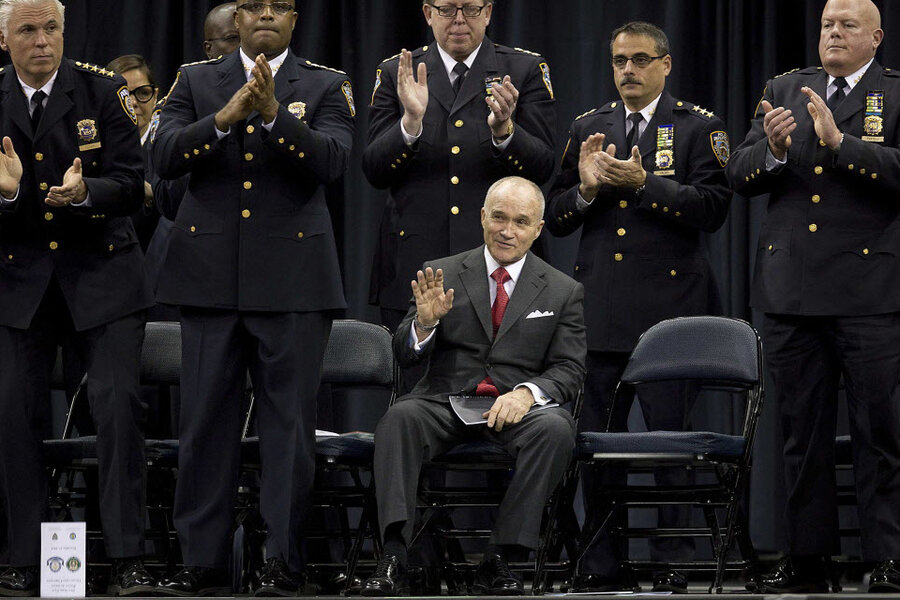Under Ray Kelly, NYPD embraced technology as policing weapon
Loading...
| New York
In the final weeks of New York City police commissioner Ray Kelly's 12-year tenure, the spotlight has been focused on the city's falling crime rate and the NYPD's aggressive use of policing tactics like stop-and-frisk.
Often overlooked in press reports about his legacy have been Kelly's efforts to transform policing in the country's biggest city through technological innovation and mass data-collection, which has been met with a mixture of praise and accusations of overreaching.
Since taking charge of a force in 2002 that was "still using carbon paper and White Out," as Kelly has said, the New York City Police Department has become, by many policing experts' accounts, the most tech-savvy in the country, and crime has dropped by a third - twice the national average, according to some studies.
Former commissioner Bill Bratton, who will succeed Kelly to the post, had in 1995 launched CompStat, a police performance management system that tracks and analyzes real-time crime data and holds precinct commanders accountable.
CompStat, which the urban think tank Manhattan Institute called "the most revolutionary public sector achievement of the past quarter-century," ushered in an era of police accountability that has been replicated in departments across the nation.
It was Kelly, however, who fully embraced technology as a policing weapon.
"I can't think of any other law enforcement leader who has such a varied amount of experience at every single level of law enforcement, and brought so much positive change to this department," said New York City Councilman Peter F. Vallone Jr, chairman of the council's Public Safety Committee.
Kelly sharply expanded data-driven, corporate-accountability management strategies, built the nation's most sophisticated municipal surveillance network, and introduced a high-tech Real Time Crime Center.
He predicted this week that technology will play an ever-larger role in U.S. urban policing, calling it a "force multiplier" that allows departments to fight crime more efficiently even with diminished forces.
"As we've shown here, it can work and it can work well," Kelly said on Monday.
DATA WAREHOUSES
One of Kelly's first moves as commissioner was to re-evaluate the department's technology. He hired top experts who studied corporate giants like Federal Express to understand how investing in technology could breed efficiency.
In 2005, the NYPD opened its Real Time Crime Center, a supercomputer which uses sophisticated data-mining tools to comb through a database filled with billions of public and classified records.
The RTCC, which operates 24/7, has allowed police to rapidly crack cases which often begin with the slimmest of leads - a partial license plate, a nickname, or even just the description of an assailant's tattoo.
"They conduct instant, on-the-spot searches, something that previously took days," Kelly said at a Missouriurban crime summit last fall.
Soon after the Sept. 11, 2001, attacks, and long before this year's revelations about the National Security Agency's secret data-collection practices, the NYPD began bringing municipal databases into its warehouse and creating new ones.
The NYPD's supercomputers can now access a universe of databases filled with building blueprints, gang tattoo photos, surveillance video, a 16 million-license-plate database, parole records, graffiti tags and a decade of 911 call records.
"Be data-driven," Kelly urged fellow cops at the crime summit. "Numbers are a police department's best weapon against crime."
When a 2012 study of New York City gun violence determined that gangs or "crews" accounted for 30 percent of the city's violent crime, the NYPD created a new database to catalog teens involved in multiple incidents, either as attacker or victim.
Kelly doubled the size of the NYPD gang unit. Within a year, statistics show, the murder rate among 13- to 21-year-olds was cut in half.
"UNBRIDLED POLICING OPERATIONS"
Critics say the department's data-collection practices have at times gone too far, not least in the controversial stop-and-frisk tactics they say amount to racial profiling.
After Kelly's NYPD created a database of individuals stopped, questioned and sometimes frisked by police, most of whom were found to have done nothing wrong, state officials in 2010 passed a law requiring police to purge any data on individuals not charged.
Throughout Kelly's tenure, the NYPD has often resisted demands from civil liberties groups for data about police operations, prompting numerous lawsuits.
"The police have the ability to make our lives transparent to Uncle Sam, but have not exhibited a comparable concern for our right to know what they are up to," said New York Civil Liberties Union executive directorDonna Lieberman. "You can't evoke national security as a pretext for unbridled... policing operations that very clearly threaten to make the fears of George Orwell look quaint."
Still, Kelly has continued to pursue technological policing advances, even into his final days in office.
On Thursday, the NYPD unveiled a prototype of a "smart" patrol car equipped with surveillance cameras, mobile license plate readers, radiation detectors and software that streams real-time data into the department's central supercomputers.
It has also been working for years on a mobile device that could make the stop-and-frisk tactic unnecessary. Developed with U.S. Department of Defense funding, it measures energy coming off of a human body and can detect a solid object, such as a gun, blocking it.
For Kelly, the race to innovate has not moved quickly enough. The first working prototype of such a device will not be available for at least two more years, he said.







